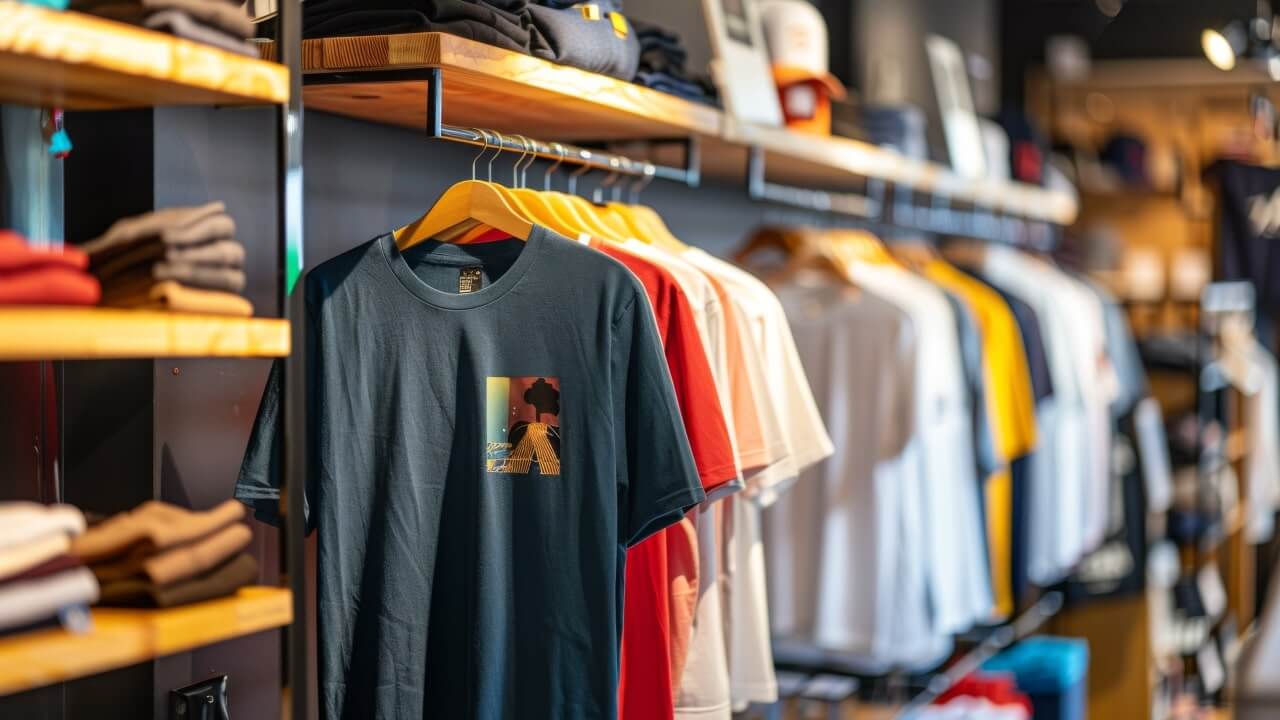Your business, your way – sell with Printify
The fashion industry is packed with big names that came to fame from a clever brand story and lucrative niche. You might have an idea yourself, but how do you develop a comprehensive business model, set up clothing manufacturers, and build customer loyalty?
We’ll get you started with five steps on how to start a clothing brand in the United Kingdom with a strong business foundation and clever use of eCommerce platforms for fulfilment and sales.
This post may contain affiliate links, which means we may earn a commission if you make a purchase through those links. This comes at no additional cost to you.
Key takeaways
- Identify a niche that aligns with your vision and target market by analysing fashion trends and customer needs both in the UK and internationally.
- To maintain a strong identity, create a consistent logo, tone, and style to differentiate your brand in a crowded market.
- Use Printify’s free platform for low-cost production, easy design tools, and global and local UK shipping without investing in upfront inventory.
- Create promotional content and utilise social media, email, and search engine marketing to build brand awareness and customer loyalty.
- Explore new sales channels, diversify your product range, focus on quality and customer satisfaction, and continuously refine your business model to scale effectively.
Perform market research and find a niche

Before we get into the nitty-gritty of starting a new clothing brand – step by step – we need to define our niche.
To identify a niche, you’ll need to conduct market research and thoroughly explore the competitive fashion industry to find viable market opportunities.
This process involves:
- Analysing market trends. Understand what’s currently popular in the fashion world, from contemporary fashion movements to universal staples that consistently sell.
- Identifying target customers. Know who you are designing for by researching community interests through social media channels and defining target demographics.
- Learning from competitors. See what existing clothing brands are doing right and wrong, from small business fashion studios to established wholesale clothing lines.
Several tools can streamline market research by analysing popular customer search keywords and online user behaviour. Use websites like Google Trends and Semrush and discover insights to start a clothing line for the right target market.
1. Develop a brand identity

Your brand identity is more than just your logo – it’s the essence of your clothing brand and the impression that will stay with customers the longest. Your own clothing brand can’t solely be the niche you’re aiming to target – it must also help your audience align with a message and goal.
Consider the four V’s of branding:
- Vision refers to the future aspirations and goals of your brand. This is where you define what you want your clothing brand to achieve in the long run, whether small and clever or largely ambitious. Consider reflecting this in your brand name.
For example, if you’re passionate about sustainability, your vision might be to become the leading eco-friendly clothing line in the UK. Your goal could also be to reintroduce traditional design styles from Celtic antiquity to promote a long-standing culture.
- Values are the core principles that guide your company’s actions and decisions. They help build trust and a deeper connection with your target audience.
For example, your clothing brand could hold a value like quality first, ensuring that all items are made from premium materials. You could also promote ethical production by committing to fair trade practices in the clothing industry and safe working conditions with a reliable manufacturer.
- Voice is how your brand communicates with its audience, both in writing and verbally. Your clothing line business must have a consistent tone across all promotional marketing channels to reflect authenticity.
For example, for a youth-oriented streetwear brand, the voice could be casual, upbeat, edgy, and even ironic, using slang and a conversational tone. However, a more elegant fashion brand would speak in a grand, formal tone that invites ambition and class.
- Visuals encompass all the eye-catching elements associated with your brand, including logos, colour schemes, typography, and product design. Visuals are the most distinctive part of a brand’s identity and should prioritise uniqueness and attention-grabbing hooks.
For example, in a luxury fashion brand, the visuals could include a sleek, minimalist logo, a basic colour palette, and high-quality images that convey elegance and sophistication. In contrast, creative illustrations could go for a more all-over-the-place look of artistic chaos.
2. Choose Print on Demand for fulfilment

Setting up clothing line fulfilment can be difficult to get your head around. Fortunately, Print on Demand (POD) offers a fantastic business structure to help you turn your design ideas into top-quality products.
Setting up your own clothing line and online store with the POD heavyweight Printify comes with multiple benefits:
- No upfront costs. Printify is 100% free to use, and you don’t need to invest money in storage facilities or logistics, significantly reducing initial expenses.
- Beginner-friendly. Printify simplifies setting up and maintaining your clothing line with its intuitive platform, from product design to online store integrations.
- Global shipping. Products can be sourced from local UK suppliers and shipped worldwide, allowing you to reach a global customer base without logistical hurdles.
- No order minimums. Your clothing business can order or sell as little as one item at a time, which is perfect for testing new designs without committing to large quantities.
- Vast product Catalog. We offer the largest range of products in the industry, so you can diversify your offerings and explore different markets and styles.
Choosing Printify for POD lets you focus on designing and marketing, freeing up time to enhance your brand’s identity and customer loyalty without worrying about logistics. Instead, we’ve partnered with trusted clothing manufacturers who will handle the printing, packaging, and shipping for you.
3. Design your clothing line

Designing your clothing line is where creativity meets business. Create your own fashion brand with our Product Creator. It’s a simple yet powerful design software with all the tools and features needed to create product mockups for listings and to get your clothing brand out there.
Create a personalised clothing line with the Printify Product Creator in a few easy steps:
Select your clothing
Find products that best fit your designs for a new clothing line. Our Catalog offers a vast collection of apparel from trusted wholesale brands with top-quality manufacturing, including t-shirts, footwear, bottoms, dresses, hoodies, and a lot more.
Create and apply your design
Once you’ve chosen your canvas, it’s time to paint it using our beginner-friendly Product Creator.
Create your own clothing designs with patterns, a logo and slogan or other branding elements, or beautiful graphics. You can combine assets like text and free images, so your creativity has no boundaries. View and edit your product mockup until you’re completely satisfied.
Prepare and publish
On the Printify dashboard, go to My products to edit your item’s title and description for your online clothing store. Be sure to highlight key features, benefits, and unique selling points while using clear and compelling language to attract and inform potential customers.
Then, publish your listing to your preferred sales channel. If you haven’t chosen one yet, don’t worry – we’ll dive into your options now.
4. Select sales channels
Choosing a sales platform is crucial to the success of your clothing line because it directly impacts your brand’s visibility, accessibility to target customers, and overall sales performance.
Our integrations allow you to publish and oversee products from an efficient central dashboard.
eCommerce platforms
eCommerce platforms provide robust tools to handle everything from product listing to payment processing. They’re great for creating a distinct online clothing store page unique to your fashion business.
Printify integrates with multiple popular eCommerce platforms and plugins:
- Shopify
- WooCommerce
- BigCommerce
- Wix
- PrestaShop
- Squarespace
- TikTok Shop
Marketplaces
Marketplaces are excellent for reaching a broader audience and leveraging established platforms’ traffic and trust in a competitive market.
Printify allows you to connect your products to popular marketplaces, making it easier to attract potential customers:
- Etsy
- eBay
- Amazon
5. Start marketing your clothing brand

Developing a marketing plan is fundamental for creating awareness and driving sales for your clothing business. Your plan should include strategies that consider your resources, tools, target customers, brand goals, and various promotional ideas.
- To begin a marketing and sales strategy, start by understanding your audience – identify their preferences, pain points, where they spend their time online and how they interact.
- Next, establish a clear marketing message based on your goals. This could be a drive to enhance brand awareness, website traffic, or conversions.
- Then, allocate your marketing budget and resources effectively across various channels, adjusting tactics based on performance.
Let’s take a detailed look at some of the key marketing channels that can effectively increase your brand’s visibility.
Social media marketing
Leverage social media advertising on platforms like Instagram, TikTok, and Facebook to visually showcase your clothing brand’s personality and products. Engaging content, influencer partnerships, and targeted ads help broaden your reach and attract new customers.
Search engine marketing
Invest in search engine marketing tools, like Google Ads, to ensure your website and storefront appear prominently in search results. Pay-per-click advertising services can attract high-intent customers who are actively searching for fashion brands.
Email marketing
Build an email list to keep your audience informed about new products, promotions, and fashion news. Sending personalised and targeted emails is one of the most direct and cost-effective forms of online marketing. It can increase repeat business and help customers see the value in your brand.
Content marketing and Search Engine Optimisation
Publish blogs, videos, and style guides from an experienced fashion designer on your website to provide value and attract organic traffic. Utilise SEO practices, such as implementing relevant keywords to improve your content’s discoverability in search results.
Tips for running a successful clothing brand in the UK
Launching a successful clothing brand in the UK requires strategic thinking and a proactive approach. Here are some tips to help you thrive.
Embrace fashion and eCommerce trends
Stay updated with emerging fashion trends and eCommerce innovations.
- Analyse the styles gaining traction among your audience and incorporate them into your product designs.
From iconic British styles with national slogans and imagery to more contemporary fashion trends in 2024, taking into account the seasonality of each product and design choice.
- For eCommerce, it’s important that your website is optimised for mobile shopping, which now accounts for over 60% of all purchases.
Also, make sure to explore emerging social commerce channels like TikTok Shop, and adopt tools like AI-driven personalisation to deliver a tailored customer experience.
Cultivate brand loyalty
Building customer loyalty can be a game-changer for your clothing company. An effective approach involves establishing a loyalty program that not only rewards repeat purchases but also incentivises referrals.
Additionally, cultivating genuine connections with customers through social media and promptly addressing their inquiries and concerns can greatly enhance their perception of your brand.
Also, try implementing personalised marketing, like birthday discounts and customised recommendations. These actions reinforce your customers’ value, fostering deeper emotional connections and long-term loyalty.
Focus on quality

Ensure your designs and prints meet high standards by collaborating with reliable manufacturers. This is easy with Printify since we provide a comprehensive overview of all Print Providers, using a merchant-rated system to evaluate them.
Emphasise your commitment to quality assurance in both production and the management of your clothing line, providing transparent information to customers. This can include detailing fabric composition and ensuring ethical sourcing practices.
Additionally, offering quality guarantees, such as hassle-free returns and refunds, can further strengthen trust with your audience.
Invest in growth
Identify areas where your online clothing business can expand and invest strategically.
- Scale up your marketing efforts.
- Explore new sales channels like seasonal UK markets or international opportunities.
- Consider hiring specialists to enhance branding, design, or customer service.
For data-driven decisions, analyse your sales stats to uncover high-performing products and untapped customer segments.
As your store grows, consider moving main operations to a new sales channel with more cost-effective subscriptions and fees.
Expand your product selection

Diversifying your product line offers new revenue streams and keeps your target market engaged. Expand strategically by introducing complementary items, like accessories or seasonal wear, that align with your brand identity.
Test new products and designs through limited-edition drops or pre-orders to gauge demand. Leveraging print-on-demand services allows for low-risk experimentation with minimal production costs, giving you the flexibility to develop a range that appeals to different customer preferences.
Start a clothing brand with Printify

Turn your vision into a thriving clothing brand and a successful business. With Printify, you can simplify production and grow your business with ease.
Start your clothing brand in a few simple steps:
- Sign up for free. Whether you want to run a small clothing business or a large enterprise, POD is a versatile solution suitable for all ambitions.
- Choose a product. Explore our wide range of high-quality clothing in our Catalog, from t-shirts and dresses to hoodies and sweatshirts.
- Apply designs. Upload your artwork or create custom designs using our Product Creator. Adjust sizes and placements to ensure everything looks perfect.
- Integrate your storefront. Connect Printify with your preferred eCommerce platform or marketplace, such as Shopify, Etsy, or WooCommerce.
- Publish and start profiting. Publish your new designs to your store and start selling at cost-effective retail prices while our Print Partners handle all production and shipping.
FAQ
Launching your own clothing line is easy with a POD platform like Printify, where you can design your clothing and sell it in your eCommerce store from the comfort of your home.
However, building a successful clothing line requires careful planning, creativity, market research, and consistent advertising efforts to ensure you resonate with your target audience.
- Conduct thorough market research and identify a niche that aligns with your vision.
- Develop your brand identity, including your logo, tone of voice, and style.
- Choose a reliable fulfilment service, such as Printify, to handle production and shipping.
- Create a range of designs for your clothing line and make product templates to visualise them.
- Integrate your online store with marketplaces or eCommerce platforms, then start marketing to reach potential customers.
Starting costs can vary greatly, depending on the business model. With POD, initial costs are significantly reduced as there’s no need for inventory or manufacturing investment. Your main expenses will be branding, marketing, and setting up an eCommerce store.
Profitability depends on your niche, target market, and how well you promote your brand. By focusing on quality, brand loyalty, and effective marketing strategies, clothing brands can achieve decent margins, especially with low overhead costs through POD fulfilment methods.
Conclusion
Starting a clothing brand in the UK has never been easier. Build a profitable business by conducting thorough research, developing a distinctive brand identity and business plan, and leveraging the power of POD services like Printify.
Remember to monitor market trends, cultivate customer relationships, and invest in growth to ensure long-term success.
Embrace your dream of becoming a fashion designer and transform your creative ideas into your own clothing brand today!












